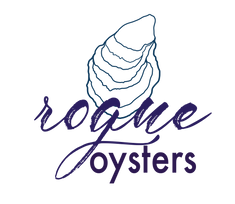So what is an oyster nursery? It will look a bit different depending on the farm, but generally a nursery is a collection of equipment designed to make it easy to grow and manage a very large number of very small oysters in a relatively small space. In one part of our nursery, we have as many as 500,000 oysters in a land-based tank that is 10’x4’x3’ — basically the same volume of water as a large hot tub.
Having so many oysters in a relatively small space makes taking care of them easier as there all easily accessibly so can quickly clean their temporary and make sure they’re not too crowded. As Taryn likes to say, it’s like running a hostel for rocks. We just have to make sure they have a relatively space where they’re not too crowded before they move on.
We could never manage 500,000 seed oysters on the farm as the equipment they need requires daily attention. 1mm oysters need a surface that’s got holes that are smaller than they are so they don’t fall out and the water can bring food in; something this tightly woven is extremely easy to get dirty and clogged, so we clean the screens daily to get rid of any algae and moss that may grown on them or sediments that collect as the water flows in from the creek. If we were to keep these baby oysters in the river, we wouldn’t have time to care for our older oysters and Aaron would have a permanent sunburn from practically living on the river. So it just makes sense to keep the small stuff at arm’s reach for easy access.
Our nursery actually consists of two parts: our land-based upweller and our floating dock. Our upweller is the aforementioned tank where we start our 1mm oysters when we first get them from the hatchery. We have a pump that forces as much as 10k gallons of water an hour to fill the upweller from the bottom up so that water must also drains out of pipes that are near the top of the upweller. These discharge pipes are inside each of the buckets, so water can only leave the upweller if it has flowed up through the buckets.

This upward flow is why it is called an upweller. Since the oysters are sitting on mesh at the bottom of 28 buckets, the only way the pumped-in water can leave the upweller is by flowing up through the oysters — providing them a buffet of algae and an ample supply of oxygen from the creek. The constant flow of creek water is the only way we know for 500,000 oysters to live in such a small space.
When our 500k 1mm oysters first go in, they usually only take up two to four buckets. Over the next six to eight weeks, these oysters will grow enough to fill all 28 buckets. When these guys start getting up to ¼”, we start separating them out from the smaller oysters. Anything that is ¼” or larger will get moved to the other piece of our nursery, our floating dock.

The floating dock is just what it sounds like. We use this to grow our oysters from ¼” up to ¾”. We hang special baskets off of the dock and let the tidal flow in the creek provide these oysters with food and oxygen as opposed to a pump. We can rely on nature instead of a pump because these baskets are a little less densely stocked than in the upweller and are a larger mesh that allows more water to flow through the gear. The flow is a lot less than the pump provides to the upweller, so the oysters on the floating dock grow more slowly, but the slow growth is worth dealing with. If we wanted to grow them more quickly, we could modify the dock to use a pump to create a floating upweller system, or flupsy. Someday we might, but we like that our system does not use an electric pump because it’s better for the environment and we don’t have to rely on our rural power grid to make sure the oysters are getting what they need.
While the oysters are on the floating dock, we take them out periodically and run them through our tumber using a tube with holes sized to sort out seed. This tube has ⅝” holes in the first half, and ⅞” holes in the second half. So when oysters go through the tube, the small ones fall through first. These small ones go back to the dock, while the larger ones are ready to go out to the farm!

The last notable part of our nursery, and Aaron’s favorite part, is the Webbed Fleet. They came from Taryn’s sister, who decided that if we had a giant tub of oysters, that tub should have some rubber ducks. Our fleet of rubber ducks help us differentiate the oysters, as we eventually have different sizes, different ages, and sometimes even oysters from different family lines all in the upweller at the same time. We need to keep all of these separate to track growth and identify any issues with particular groups of oysters. Rubber ducks aren’t the most technologically advanced system, but they will always be a part of the farm in some form as it evolves.

Leave a comment